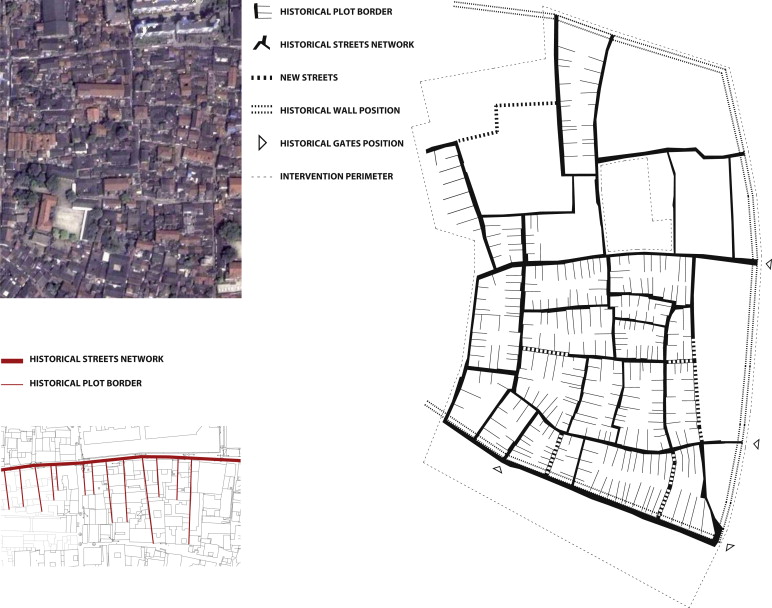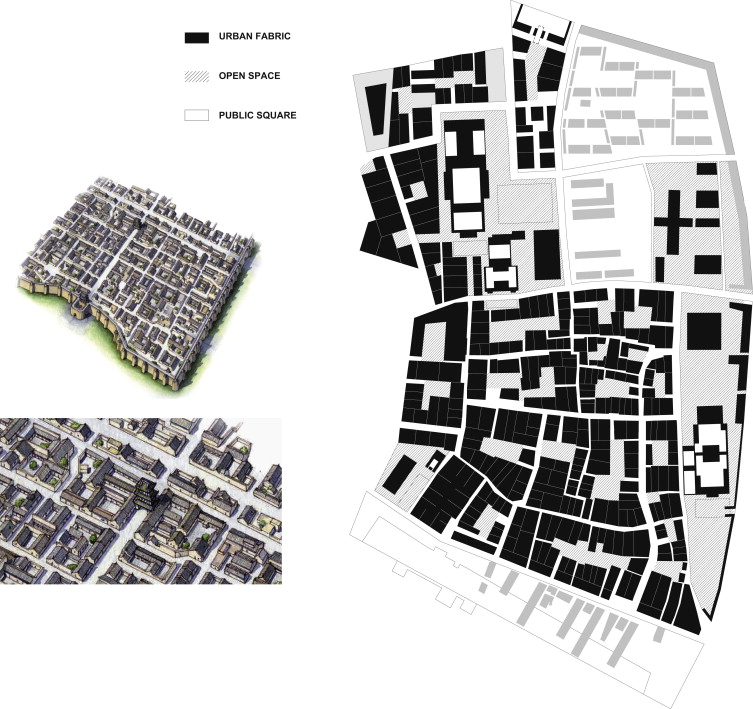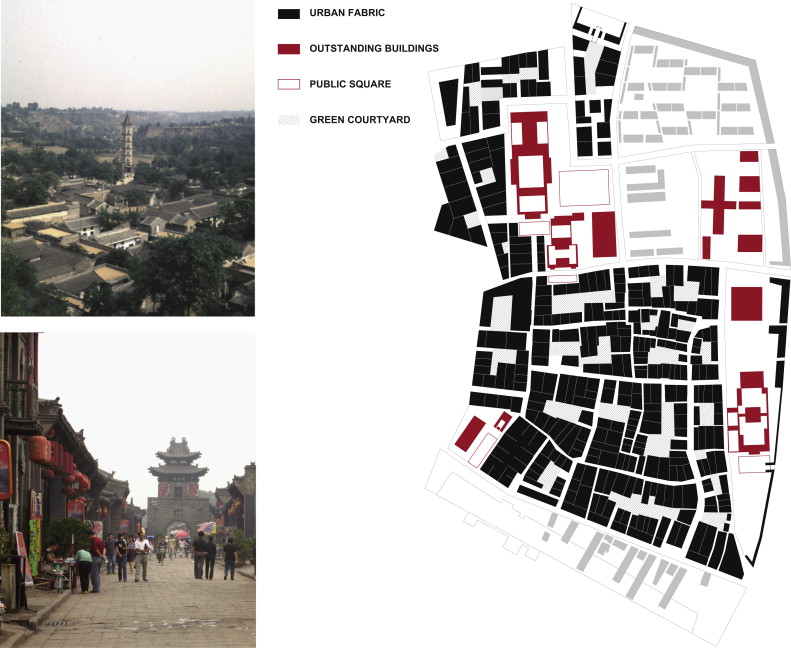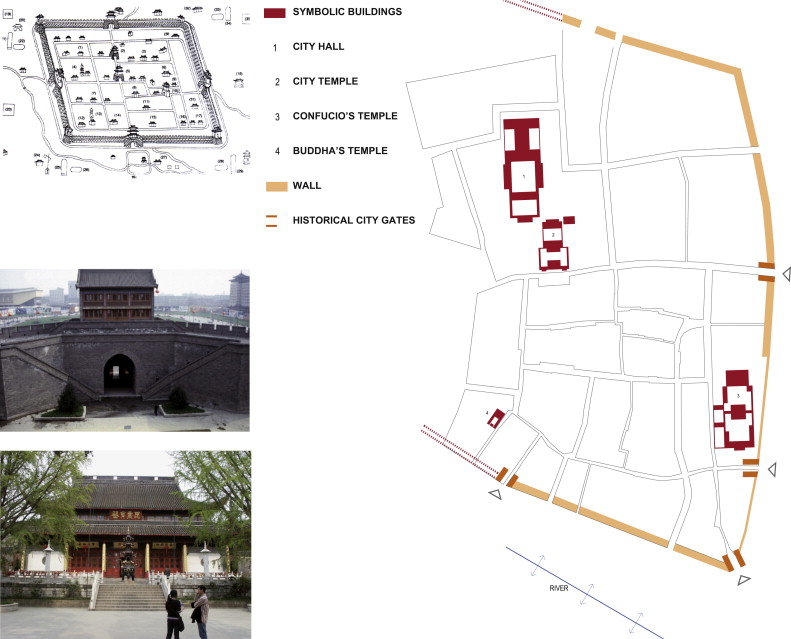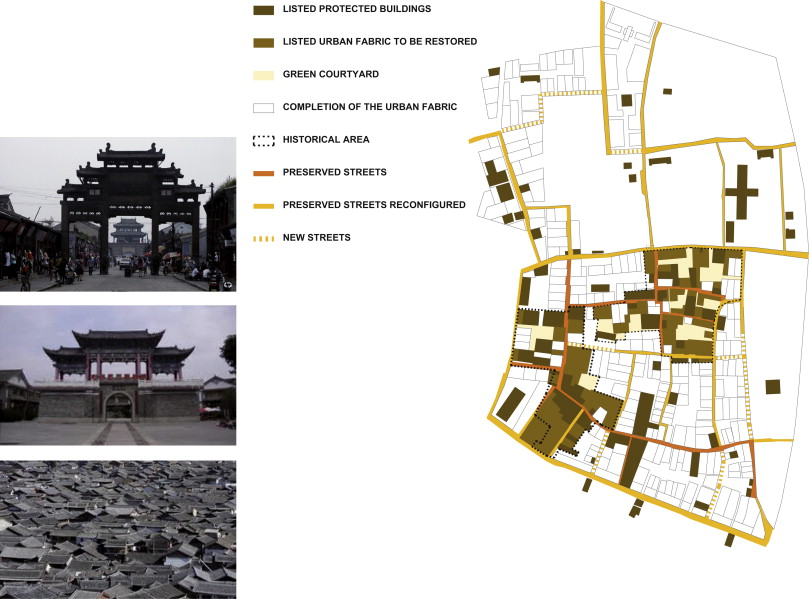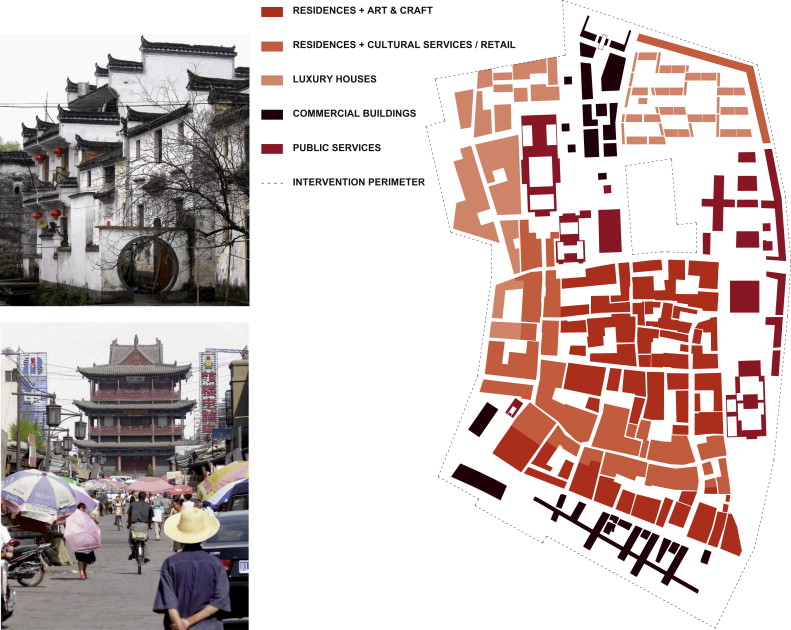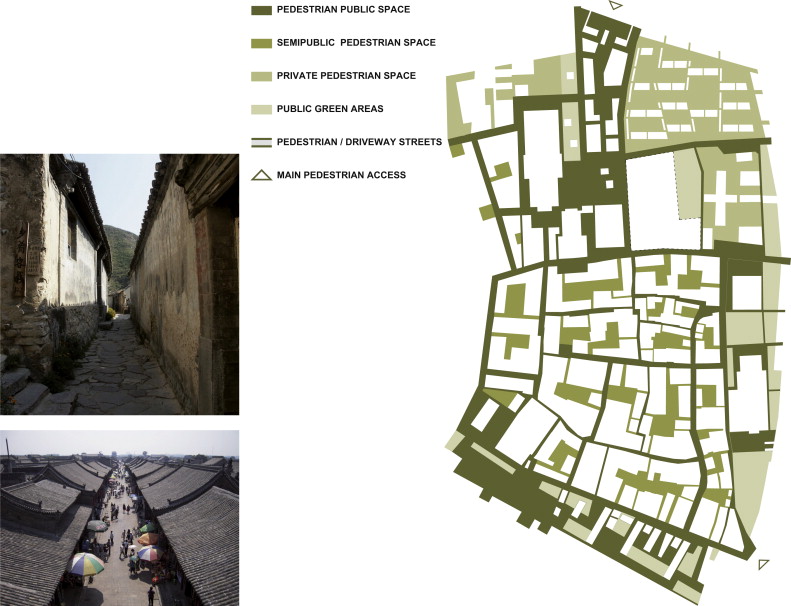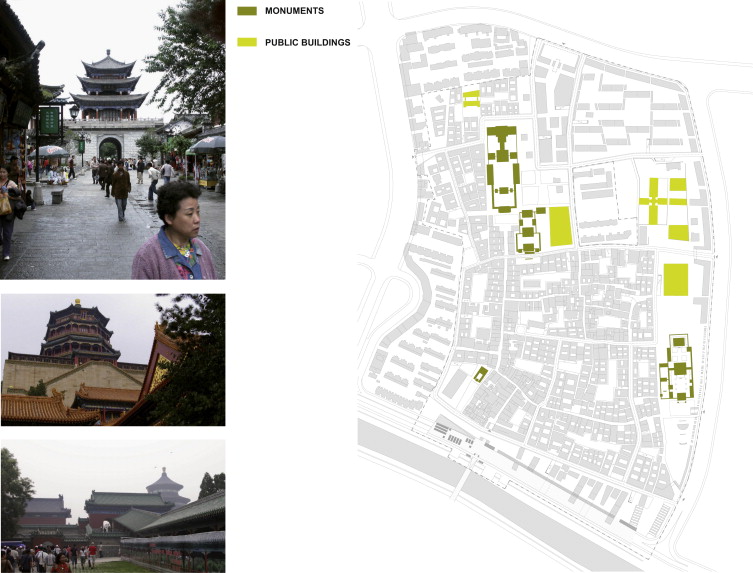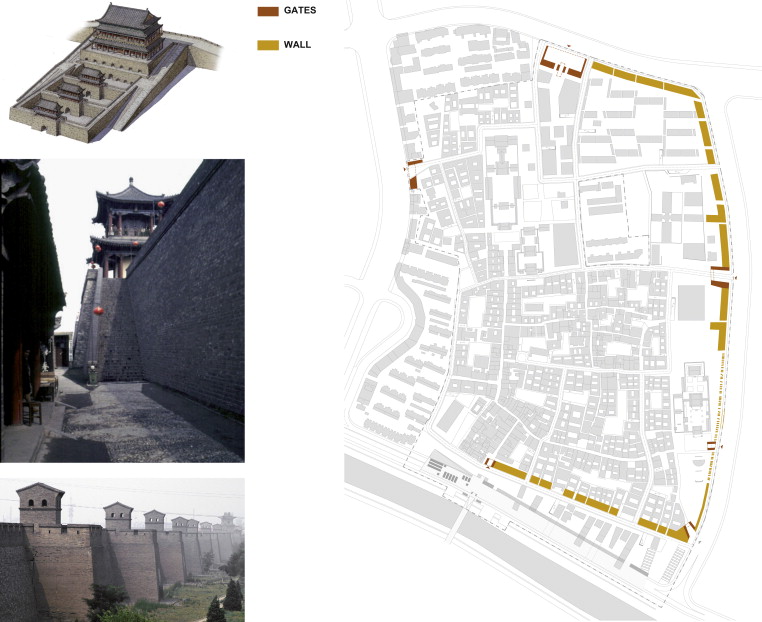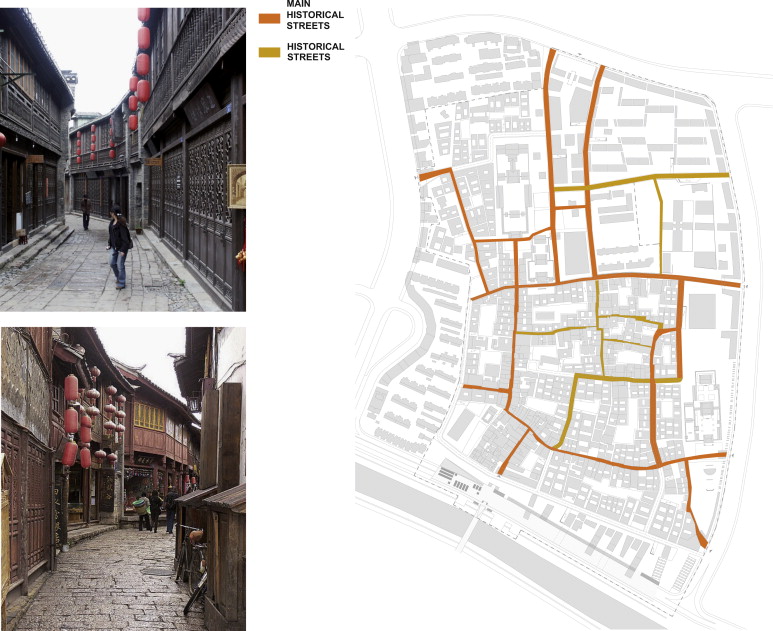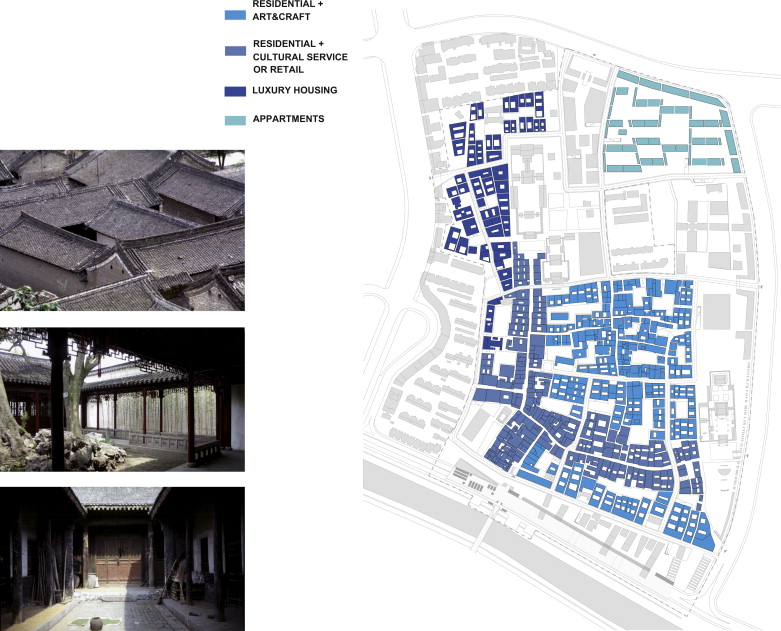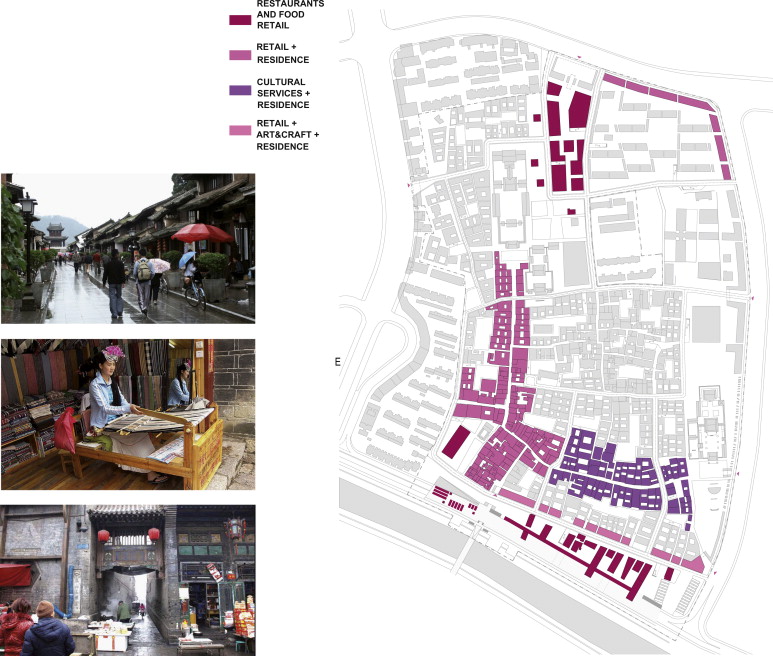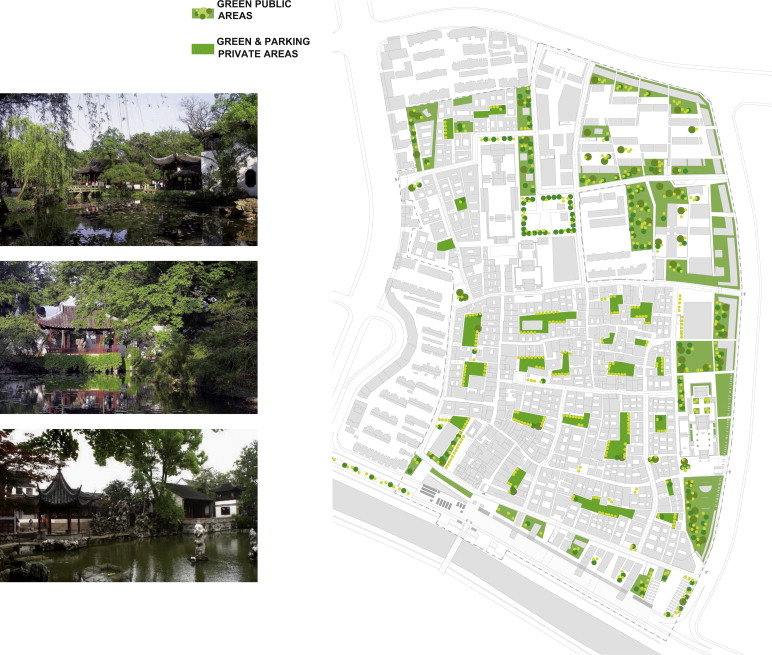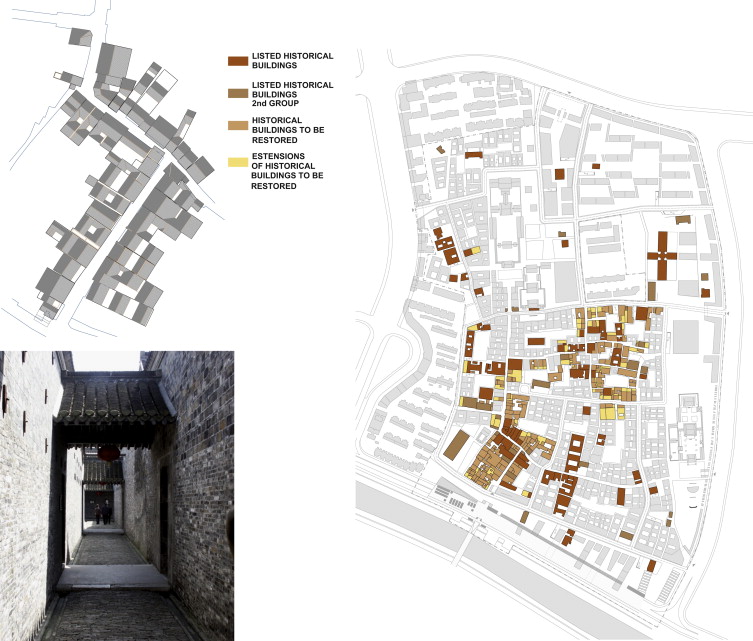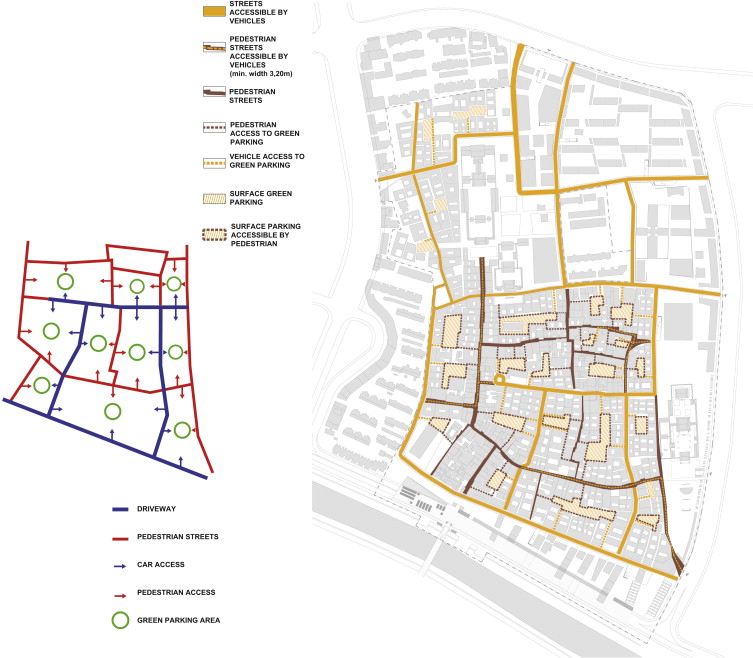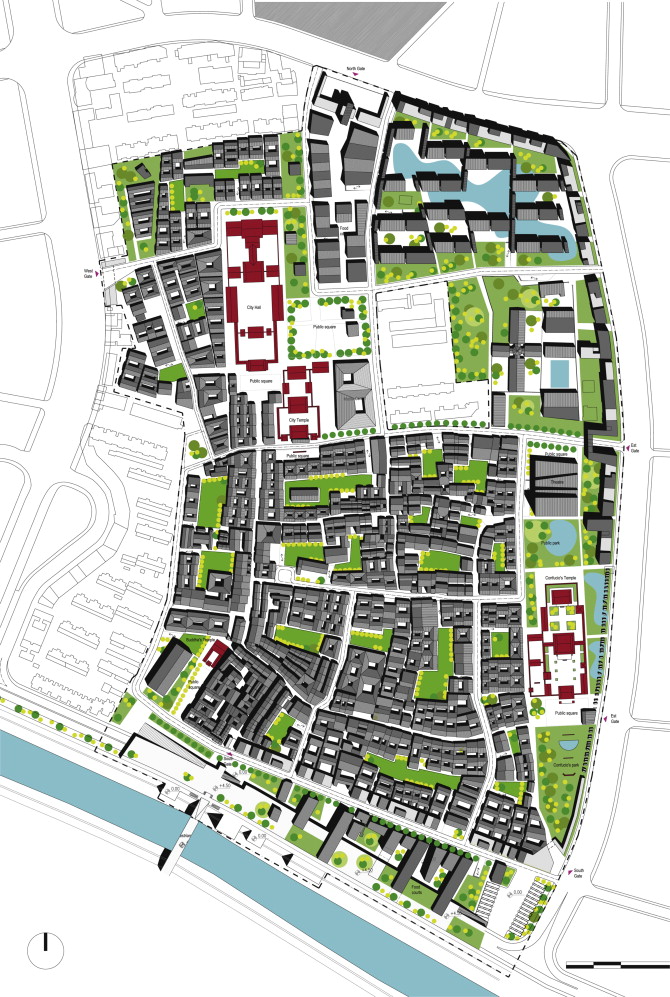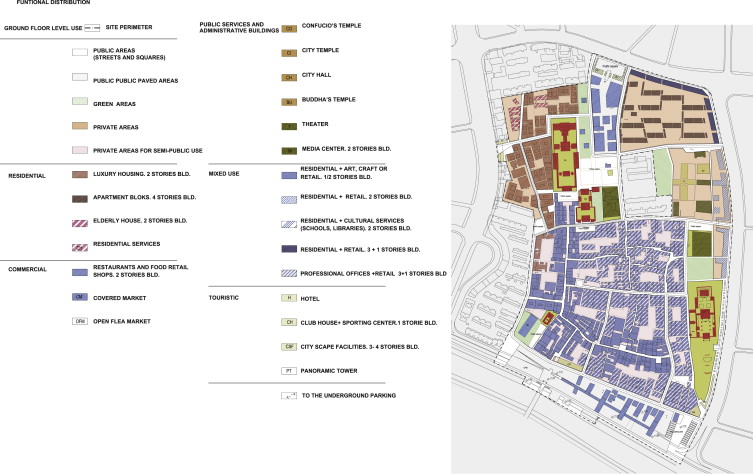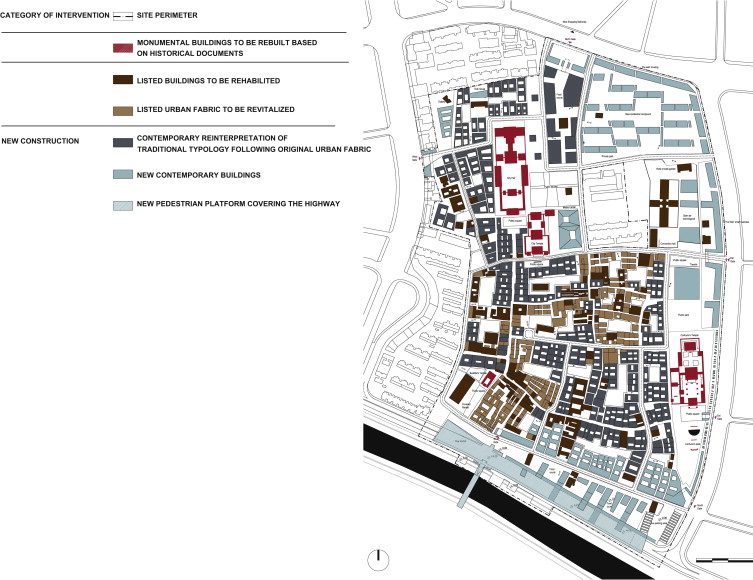Abstract
Restoration and redevelopment are difficult when traces of things that require preservation have been minimized. Such operations are even more complex whenever a portion of an ancient city is involved. This essay describes the redevelopment project of the historic center of Wuhu through the different themes raised during the drafting of the project: from the cultural opportunity of a wide reconstruction work, to the definition of the main design strategies, and the question of memory and identity.
The results show that the field of intervention in this project is broader than that of most restoration projects, that is, an evolving city center, which is impossible to consider with traditional restoration parameters or with pure conservation. The only possibility of intervention is on the city structure, which allows the city to develop itself continuously within a well-defined system of rules.
Keywords
Historic center ; Redevelopment ; Reconstruction ; Restoration ; Identity ; Collective memory ; Urban fabric ; Monuments ; Urban grid ; Typology ; Persistence
1. Introduction
The redevelopment project for the historic center of Wuhu in Anhui Province requires the consideration of a hard set of themes and general questions and specific issues related to the project itself. The almost complete destruction of the foremost historic buildings of this town occurred during the last century. Those who intend to manage the redevelopment project face a twofold issue because of the poor conservation of the few surviving residential buildings that date back to the period prior to the 20th century.
The first issue concerns the worthiness of implementing a restoration plan if past elements are almost completely lacking.1 The second issue involves the means to achieve such work, that is, whether to perform a reconstruction rather than a restoration.
Therefore, the following question emerges: is it sensible to rebuild the historic center, which has already been gone a century ago? Which economic, social, and political role could or should the new historic center retain? Is the reconstruction of a historic center based on very few true permanencies culturally feasible?
1.1. Role of the historic center
Obviously, providing an exhaustive answer to these unopened issues would entail long discussions. The cultural accuracy of redeveloping a historic center and the scientific criteria to be adopted to validate the redevelopment are unclear.
In the closest examples, the meaning of historic center can only be reflected upon to understand the importance of the construction and definition of a city.
In the history of Western cities, historic centers obviously have continuously represented the pulsing heart, identity, memory, and development driver of cities. The center is where most intense and remarkable experiences of urban facts occur ( Rossi, 1966 ). Therefore, besides the aforementioned cultural issues, the role of historic center in a city is rather essential and undeniable in the overall balance of the city itself, as marked by two aspects. The first aspect is related to the collective memory, which is a common heritage that represents the identity and sense of belongingness of people in a community. According to Bernardo Secchi, historic centers are places where “the history of entire societies and past cultures are expressed tangibly” (Secchi, 2007 ); this statement does not only imply the possibility of providing a historic evidence to future generations, but most importantly enables creating an essential bond that is typical of any permanent society among men, the community, and the environment. One of the reasons many contemporary outskirts are rejected by the inhabitants of these outskirts is the broken bond between men and the environment, which is typical of historic centers.
The second aspect comprises a public space, which is “a space located in public; where various collective rites, parties, and religious processions occur; and where people go for a stroll” (Secchi, 2007 ). The historic center space is a hybrid and is subject to the most varying and practical interpretations; a historic center is internal, protected, and characterized by excellence. A historic center is a space intended for everyone and is the arena for collective representations, while remaining as an intimate place because the space is closed and defined by street voids, margins of squares, rhythm of arcades, and backgrounds of public buildings.
Assuming the accuracy of reconstructing and redeveloping the historic center is now a matter of defining the scope and methods for reconstruction and redevelopment.
1.2. Structural project
Restoration and redevelopment are difficult when traces of the things that require preservation are minimized. Such operations are even more complex whenever a portion of an ancient city is involved, which necessarily lives and functions according to the requirements of the contemporary society, especially if the objective is to regain a central and specific role for the future development of the city, as in the case of Wuhu.
Such project should not aim to conserve the pure form, as in most cases of restoration projects. However, a project should intervene on the structure of the form, which allows the structure to develop itself continuously within a well-defined system of rules.
Unfortunately, conservation policies have been dominated by unclear, documentary, and pedagogic intents to create sets of values that sometimes contradict with the history expected to testify. Especially in historic centers, history implies a never-ending process of transformation and rewriting for both buildings and urban spaces, which have been creating an extraordinary palimpsest over time. This palimpsest is typical of every ancient city. Similar to what sometimes occurs in mere conservation practices, attempting to freeze an ancient city to an unchangeable state is illogical. What generally remains unchanged over time, if not through slow adjustments, is the structure of the place, which is intended to be preserved.
Given that Wuhu is a historic center, the structure is principally represented by a set of signs and traces illustrated by the grids of roads, alleys, and squares, up to the lot divisions. In this case, a structure that follows the pattern of the urban fabric corresponds to the shapes of the voids.
Fortunately, this Wuhu structure is still visible and remains untouched. Precisely retracing the original layout according to historic maps, which is the backbone of the ancient city, is possible. Most historic buildings are lost, but the roads are still intact and accessible.
Therefore, the persistence of the street layout has become the plan-generating structure. This structure is the main focus of each urban research because understanding this structure allows the return to the spatial development of the city. This structure comprises the notion of persistence, which also applies to the fabric of buildings, roads, and monuments, given that a “city is something that lasts throughout the transformation processes, and the simple or countless functions of a city are just moments in the reality of the city structure” (Rossi, 1966 ).
Therefore, this evolving structure, which enables and includes transformation, is lasting. Hence, every single element is conceived as a part of a system, which is the city. A city provides the criteria for the requirement and actuality of the architectures that tend to change overtime.
1.3. The issue of identity and memory
Permanent city structures usually have physical characters: road layouts, main alignments, squares, and monuments. The survival of these signs testifies that the physical characters of a city are maintained throughout history.
Aside from the physical structures, some features exist that are linked to collective memory, which offer a deeper knowledge of urban facts and of the abstract form of these facts. Given that it is defined as the “soul of the city”, things related to the quality of these facts go well beyond the description of the morphological aspects.
Generally, a city is the collective memory of a community. Given that the memory is related to facts and places, a city is the place of the collective memory itself. Thus, a city becomes the common thread of the whole and complex urban structure. Therefore, single buildings and monuments that qualify the urban landscape are important to define consciousness and collective memory: “the characters of entire nations, civilizations, and epochs speak through the set of architectures that these architectures achieve, as if these architectures are external covers of the architectural being” (Burckhardt, 1958 ).
Hence, one of the problems of Wuhu is the total destruction of the city monuments over the last century. Nevertheless, the community still respects some symbolic places, which demonstrate that collective memory is stronger than physical presence. For example, citizens continue to pray and bring offerings in front of the door of the previous Temple of the City even if the building has been demolished almost half a century ago (Figure 16 ).
2. Design strategies
2.1. The bidimensional structure
The first step that defines the redevelopment project of the historic center of Wuhu is the research and identification of a bidimensional structure of the plan.
As mentioned, the elements of a city that generally do not change or vary with time, such as roads, lot dimensions, urban and residential types, and monuments, form the quintessence of a city itself and are its permanent parts.
This set of elements contributes to building the city structure. These elements become evident by carefully analyzing historic maps, and ancient and contemporary cadastral layouts, and by thoroughly analyzing the signs, layouts, and everyday habits of the place. Therefore, it is a matter of choosing and operating a careful selection and distinction among secondary and transitory elements, which must be discarded, as well and those elements that effectively determine the form and identity of a place.
Therefore, acknowledging this endogenous structure is a turning point between analysis and synthesis during the design of the project. By acknowledging this structure, we have studied the historic center of Wuhu. Fortunately, the original streets of the Ming dynasty and the original layout of the ancient courtyard houses noticeably remain either unchanged or retraceable compared with the carelessness and demolitions that the historic center has underwent. The same goes for the position of the urban walls surrounding the city center, whose current layout has been replaced by a driveway, and the locations where the main landmarks of the city are located.
By merging the detectable empirical data in situ and analyzing historic documents, tracing a rigorous grid that represents the geometrical backbone of the new plan has been possible. The location where the road structure appears incomplete or interrupted has been integrated with new segments by following the existing geometrical matrices through an analogical method (Figure 1 ).
|
|
|
Figure 1. Illustration of the bidimensional structure of Wuhu, and an aerial image of a typical Chinese historic center. |
2.2. The three-dimensional structure
A city generally comprises the occurrence of built volumes and open spaces, or masses and voids: houses, schools, offices, and any other buildings act as the masses, whereas roads, squares, parks, and other open spaces represent the voids.
The relationship between masses and voids, which is often called “figure background ” ( Rowe and Koetter, 1978 ), is one of the main aspects that characterize the different forms of a city over time. By contrast, in a modern city, and quite often even in a contemporary one, buildings are generally immersed in an open and unstructured space. In pre-modern times, buildings and voids have a two-way relationship that defines a unique figure or structure. As observed by Bernardo Secchi, the element that characterizes an ancient city is the physical and spatial datum that can be experienced in an open space, which is completely lost in a modern city because of the excessive expansion of open spaces.
Therefore, in the project for the historic center of Wuhu, we have primarily attempted to define a correct proportion among various elements, which is a three-dimensional structure that can recover the typical spatial relationships of the ancient city: the proportion between the street width and the building height, between streets and squares, and between main buildings and open spaces (Figure 2 ).
|
|
|
Figure 2. Relation between mass and void: the three-dimensional structure. |
2.3. Urban fabric and monuments
As observed by Aldo Rossi, the relationship between urban fabric and monuments and between residential and emerging elements is one of the features that truly embody a city. This observation can be identified both in cities where historic events lead to the merging of various elements that represent urban panorama, and cities where these events are characterized by very different urban episodes.
Although cities are mostly composed of residential buildings, the emerging elements can accelerate and orient the urban intentional process, acting as catalysts within the dynamics of urban growth. These elements often coincide with monuments. Hence, these elements cover the main public function.
However, this case is not always true. Sometimes, the elements may be identified with private buildings instead, which interrupt the continuity of the urban fabric because of the size and monumentality, or with facts and events of the elements, and not with buildings that determine the specificity of a place.
In the historical center of Wuhu, which is characterized by a dense urban fabric of courtyard houses, monuments are located along the walls, as the case of the Confucian Temple and the old prison, or along the north/south axis that connects the two city doors to the city. This axis coincides with the “road of the flowers” and connects the river and the Buddha Temple southward to the city temple and the municipality northward (Figure 3 ).
|
|
|
Figure 3. Relation between urban fabric and monuments, and some images of traditional Chinese city gates. |
2.4. Symbolic elements
A city does not only comprise physical objects, such as buildings, monuments, and open spaces, but also intangible identities, which are sometimes more important than material ones, such as the city history, culture, and beliefs, which are called “the spirit of the place. ” Much has been written about this topic, such as the famous book “Genius Loci” by Norberg-Schulz (1979) . This author explains the intrinsic potentials of the transformation of each place and environment that transform over time, starting from the Roman idea of genius , that is, the “guardian spirit” that leads the fate of a locus (place).
We do not aim to highlight the “existential” aspect of the human environment relationship, but to ponder on the previously stated idea of a city as a place of collective memory. In this regard, spirit is a feature of a city that is shaped by the experiences, memories, and habits of the city inhabitants, and is stratified over time. Spirit is a character that makes living in a certain area unique for people.
The city hall, Temple of the City, Confucian Temple, walls, and urban doors in Wuhu are still alive in the minds of the people because these structures represent and symbolize the tangible and intangible past of the city. Therefore, reconstruction becomes necessary to preserve this memory.
Long discussions have emerged about the appropriateness and cultural coherence of rebuilding the symbolic monument of the city, but the answer itself has been provided by the Chinese cultural tradition. This answer may be referred to the myth of the phoenix (Gazzola, 1999 ), which always rises renewed from the phoenix׳s own ashes. In the past, any building in China, from the simplest to the most important, is cyclically demolished to be rebuilt in the same place. Hence, the original materials are partly reused. According to the traditional Chinese architectural culture, preserving the physical fact is meaningless compared with the symbolic one (Figure 4 ).
|
|
|
Figure 4. The most important symbolic elements of the historic center of Wuhu, and some images of traditional Chinese temples and city gates. |
2.5. City identity
City identity does not only depend on the conservation of the monuments or, more generally, the main buildings in the city, because these monuments have been previously defined. The character of a city depends equally on the preservation of the basic urban fabric; ordinary residential types; dimensional and functional relations between roads and residences; rhythmic growth of the block; and relationship between public and private spaces within a single lot and within the block itself.
City identity does not depend on the mere preservation of the form because this idea would contradict one of the peculiar aspects of urban dynamics, given that form is a continuous evolution of the typologies of one of the most interesting aspects of a city. City identity is a matter of preserving those invariant or structural characters that persist over time, and determine the essence and characteristics of each urban area.
The urban fabric in the historic city of Wuhu has been categorized into three: protected monuments, which should be preserved by applying scientific conservation criteria; urban fabric, which requires refurbishment, i.e ., the part of the city where some original elements remain but with different alteration degrees (in this case, the action shall envisage a selection of characters to be preserved, and a transformation process in accordance with the original typological characters and the new intended use); and parts of the city that require rebuilding. An action has been defined for the latter category that respects the typological, morphological, and structural properties of the Wuhu tissue.
The reference type is that of a Siheyuan courtyard house, which is organized into two levels and is displayed perpendicularly to the road on a narrow and deep lot with one or more courtyards depending on the lot depth. The structural bay generally coincides with the lot width, hence, the perimeter walls on the long sides coincide with the load-bearing walls of the building. The roofs are pitched with an impluvium toward the courtyard. In the new urban fabric, the architectural language shall differ from the ancient one, while respecting the aforementioned characters (Figure 5 ).
|
|
|
Figure 5. Survey of the existing buildings to be preserved, and some images of the traditional Chinese urban tissue and city gates. |
2.6. Complexity and functional mix
Modern urban planning based on zoning has led to positioning the main daily activities in various places of the city, which ensures that the office district remains separated from the commercial one, as in the case of residential areas or those for recreational activities. Conversely, the historic city is characterized by a deeper programmatic complexity that envisages a more intricate and layered functional structure: a dwelling is not only a place to stay or rest but also a place to work or sell goods. The same idea applies for the streets of the historic center. These streets are not only places for communication and transportation but are also places to stop, eat, work, play, and do business.
Thus, as parts of this major programmatic complexity, the streets and districts of the center have acquired a specific vocation over time, which is linked to specific commerce types or handcrafts, namely, metal district, textile district, and wood or ceramics, food market, flower market; and areas dedicated for selling food.
In the project for the historic center of Wuhu, we have attempted to comply with both programmatic complexity, which is typical of any historic center, and vocation of each road or district to specific commercial and productive activities. Therefore, public services are located along the city walls westward and near the Temple of the City, whereas the food districts are concentrated along the river southward and near the urban door northward. The areas along the ancient “road of the flowers” retain the original vocation of a mix of business, residential, and cultural activities, whereas the heart of the city center remains mainly residential with spaces for small commerce and handcraft activities at the ground floor (Figure 6 ).
|
|
|
Figure 6. Functional urban mix of the master plan, and some images of traditional Chinese houses. |
2.7. The pedestrian city
The streets of the modern city are mainly conceived and designed to accommodate cars. Given that the streets are separated from the buildings, life in buildings is separated from life in the streets. Previously, streets are primarily intended for pedestrians. The streets are even sometimes wide enough for one person only, whereas the main roads are dimensioned to let carriages pass through. Moreover, many previous activities have been performed in the streets, making the streets complex places, where important collective and daily events occur.
At present, it is important to recover the notion of road and urban open space where pedestrians can move freely and cars are separated as strange objects. This notion envisages open spaces of streets and squares as places with dense expectations and spaces where citizens can stop, meet, play, and perform various activities. A pedestrian city requires care and attention toward the quality of the life of the citizens. These vitality and versatility must be recovered and passed on to future generations in the redevelopment project for the historic center of Wuhu, the structure of open spaces has been designed to maximize the size of pedestrian traffic and minimize that for vehicles. The public, semi-public, or private characters of these spaces have been duly considered in the study of open spaces. Therefore, open spaces have been classified into the following: totally pedestrian routes and public squares, public roads for vehicles and pedestrians, semi-private pedestrian spaces and/or vehicular traffic areas between two blocks, public green areas, semi-private green areas, and private courtyards (Figure 7 ).
|
|
|
Figure 7. Illustration of the pedestrian use of the open space, and some images of traditional Chinese streets. |
3. Elements of the plan
3.1. Monuments and public buildings
In a city, monuments and large public buildings are emerging elements that accelerate and catalyze urban growth; these structures are significant both from a social and from an urban morphology standpoint.
The requirements for rebuilding and revealing buildings with symbolic values, and repositories of collective memory have been mentioned already. These values are mostly religious characters or representations of political power. Envisaging the construction of new civic buildings dedicated to culture, such as theaters, libraries, and civic centers, has been deemed necessary to hasten the redevelopment process of the center.
Therefore, the project addresses the reconstruction of the four most important historic monuments, namely, Town Hall, Temple of the City, Confucian Temple, and Temple of Buddha, on the exact locations where these structures used to stand. In addition, the project aims to build the structures with the original shapes and materials, following the ancient documents.
By contrast, a contemporary interpretation has been proposed in the case of new public buildings. The project envisages the creation of a media library near the Temple of the City to form a system of relevant squares and public spaces with this library and the Town Hall. A multi-purpose theater is constructed near the west city door, and the former prison is transformed into a hotel with facilities to create an ensemble of cultural and recreational services together with the new theater and a part of the west wall, including the gate, which are all surrounded by green areas (Figure 8 ).
|
|
|
Figure 8. Monuments and public buildings, and some images of traditional Chinese monuments. |
3.2. Doors and city walls
One of the main features of the ancient city from east to west is the presence of walls that protect the urban area. Physical and psychological boundaries are used to clearly mark the inside and the outside of the city, thus, separating the inside, which is protected and recognizable, from the outside, which is unknown and dangerous.
As the urban area expands after the first post-industrial urbanization, the urban walls are overtaken, and the walls are no longer necessary to protect the city. In addition, the walls are culturally rejected and often demolished after being abandoned, thus, gradually falling into disrepair. Given the disrepair of the walls, one of the most characteristic morphologic elements of the ancient cities is lost.
Unlike in western culture, the idea of enclosure in the Chinese culture is fundamental to conceive a built space. The interior space from the dwelling to the city is always separated from the outside through a sequence of fences, walls, or doors that are ordered non-prospectively.
Therefore, the total loss over time of the ancient city walls in Wuhu has encouraged the reproposal of a closing structure along the perimeter of this historic center to return one of the most important symbolic elements of the city. We do not propose philologically reconstructing the ancient city walls, but building a contemporary wall that is thick enough to make the wall inhabitable to fulfill the requirement of a physical margin, which is the limit that encloses a city. A wall undergoes modulations and typological variations, together with the unwinding of the wall, according to the areas that the wall laps (Figure 9 ).
|
|
|
Figure 9. Identification of the system of city doors and walls, and some images of traditional Chinese city doors and walls. |
3.3. Historic urban grid
The most important element acquired from the history of Wuhu City is the urban grid that dates back to the Ming dynasty. Most of the ancient buildings have been demolished at present, but the streets remain original, regardless of the preservation of the facades on one or both sides. Therefore, one of the most important aims of the project is to preserve not only the roadway but also the pedestrian vocation, dimensional proportions, and programmatic wealth of the city (Figure 10 ).
|
|
|
Figure 10. The main historical streets in Wuhu, and some images of existing streets in the center of Wuhu. |
3.4. The residential fabric
Cities are mostly characterized by the presence of residences. Without residences, a city would be meaningless. Monuments represent the catalyzing elements and propellers of urban process, but residences impress a specific character, which is the underlying tone of the complex urban symphony. Therefore, the conservation of the residential tissue is one of the main elements of any redevelopment action applied to urban areas.
In the transformation dynamics of the urban fabric of the historic center of Wuhu (Caniggia and Maffei, 1979 ), a Chinese courtyard house is the basic residential type. Over the centuries, this house has developed with many changes, mergers, and divisions to a type that extends mainly in the depth of the lot with a reduced size street front. To occupy the lot fully, the dwelling, which originally has a single central courtyard, is provided with more additional open spaces or internal courtyards, which are necessary to shed light into each room. The result is a rather complicated sequence of rooms that alternate built and non-built spaces starting from the road.
This situation is still visible in few surviving historic dwellings within the historic center, except for the various recently built alterations and additions. However, by reading the cadastral layouts and examining the structures, materials, and construction technologies, retracing the original stage of the dwelling and designing the building according to the transformation rules of the building are possible.
This process applies to the definition of the intervention criteria both in the case of conservation and restoration works, and in the design of a new urban fabric (Figure 11 ).
|
|
|
Figure 11. Differentiation of the residential fabric, and some images of existing houses in the center of Wuhu. |
3.5. The system of trading areas
The foundation and growth of Wuhu are thoroughly connected to the commercial nature of the site. Originally, this site is for wholesale, but the site has become a place for retail trade as the city gradually expanded because of the movement of the wholesale activities outside the city.
The first trading activity begins along the riverbanks, which exploits the ease of movement guaranteed by the waterway, whereas retail trade evolves along the main road connecting the Confucian Temple to the east with the door of the Temple of the City to the north, which results from the urbanization process of the site. This L-shaped path, a part of which has been occupied by the “road of the flowers,” is still well preserved although many of the buildings on the sides have been recently demolished and rebuilt.
The project aims to return a significant commercial role to both sites. The areas along the river shall become a food retail area, whereas the internal road shall be devoted to local handcrafted products retail. The other trading areas are located north of the center, where a second district dedicated to catering and sale of food will be added, and a system of small commercial facilities at the ground floor of the buildings in the new urban wall to the north (Figure 12 ).
|
|
|
Figure 12. System of trading areas, and some images of traditional Chinese market streets. |
3.6. Network of green areas
Many non-built private and public areas are held by the city at the onset of the foundation of a city. These areas are gradually built during the growth stage in a process of saturation of the available spaces throughout the expansion stage. The last areas to be built are those inside the urban blocks and those along the city walls for security reasons.
The redevelopment project envisaged locating most of the new green areas in these two positions to pursue the currently inescapable objective of the city with large green permeable spaces, according to the history of the place itself.
Particularly, the areas inside the blocks shall be destined to private green areas that surround residential buildings. The areas adjacent to the city walls shall form a continuous system of green spaces for public use, interposed with a set of facilities and buildings intended for the community (Figure 13 ).
|
|
|
Figure 13. Network of green areas, and some images of traditional Chinese gardens. |
3.7. Redevelopment and restoration
Traditional Chinese architectural culture is based on the conservation of intangible elements, such as language rules, building technologies, and materials types, and on the demolition of physical objects, such as buildings and some parts of the city. Buildings and physical items are cyclically replaced by new ones. This attitude, which is very different from the conservation culture established in the west, is currently changing. Currently in China, the cultural trend is preserving and restoring existing historic buildings.
In the project for the Wuhu historic center, we have decided not only to conserve protected buildings but also to recover the original urban fabric that has survived (Figure 14 ).
|
|
|
Figure 14. Redevelopment and restoration, and the definition of different kinds of interventions. |
3.8. Urban blocks and accessibility
Given that the project preserves the existing urban grid, the building blocks maintain the original shape. Maintaining this original shape has created many problems in the management of vehicular traffic. To solve this problem, the system of networks has been divided, serving each block with both a system of pedestrian pathways that follow the old street pattern and a network that uses existing broader roads for vehicles, thus, penetrating the block. Every building block encircles a green semi-private space, which is connected to both the pedestrian and the vehicular network. Hence, accessibility for vehicles is guaranteed for every housing unit, which divides driveways in public streets.
The advantages of the historic pedestrian city are combined with those of the vehicular contemporary city (Figure 15 , Figure 17 ; Figure 18 ).
|
|
|
Figure 15. Accessibility inside the urban blocks. |
|
|
|
Figure 16. Master plan of the redevelopment of Wuhu. |
|
|
|
Figure 17. Zoning of the new master plan. |
|
|
|
Figure 18. Intervention methods. |
References
- Burckhardt, 1958 Burckhardt, J., 1958. Weltgeschichtliche Betrachtungen. Italian translation. Studio della storia, Turin.
- Rossi, 1966 Rossi, A., 1966. L’architettura della città. Padova.
- Rowe and Koetter, 1978 Rowe, C., Koetter, F., 1978. Collage city, Cambridge–Massachusetts.
- Norberg-Schulz, 1979 Norberg-Schulz, C., 1979. Genius loci. Italian translation. Genius Loci, Milan.
- Caniggia and Maffei, 1979 Caniggia, G., Maffei, G.L., 1979. Lettura dell’edilizia di base, Venice.
- Gazzola, 1999 Gazzola, L., 1999. La casa della Fenice, Rome.
- Secchi, 2007 Secchi, B., 2007. Prima lezione di urbanistica, Bari.
Notes
1. In our case, the percentage of the ancient buildings in the historic center was less than 15%.
Document information
Published on 12/05/17
Submitted on 12/05/17
Licence: Other
Share this document
Keywords
claim authorship
Are you one of the authors of this document?
